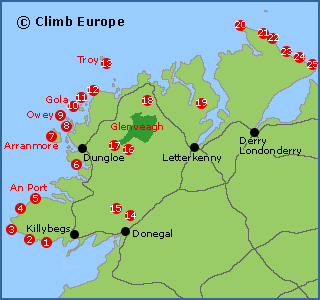Rock Climbing in Donegal
Situated in northwest Ireland, Donegal provides a huge variety of rock climbing. The map below shows the location of the main crags in Donegal that provide many single and multi-pitch routes by the sea, by the road, on the islands and in the mountains.
Map of the rock climbing areas in Donegal

The information in the table has been extracted from the Rock Climbing in Donegal guidebook that describes the best 1,000 routes in Donegal and is available to buy from our shop.
| No | Crag | Type of Rock | Grade Range | No of Routes in Guidebook | Single or Multi-Pitch |
|---|---|---|---|---|---|
| 1 | Muckross Head | Sandstone | D to E7 | 56 | Single |
| 2 | Sail Rock | Quartzite | VS to E6 | 4 | Multi |
| 3 | Malin Beg | Quartzite | D to E4 | 57 | Both |
| 4 | Skelpoonagh | Quartzite | D to E2 | 26 | Both |
| 5 | An Port | Quartzite | M to XS | 45 | Both |
| 6 | Crohy Head South | Quartzite | VD to E2 | 14 | Single |
| 7 | Arranmore Island | Granite and Quartzite | D to XS | 4 | Both |
| 8 | Cruit Island | Granite | D to E4 | 134 | Both |
| 9 | Owey Island | Granite | VD to E6 | 96 | Both |
| 10 | Gola Island | Granite | D to E5 | 146 | Single |
| 11 | Umfin Island | Granite | VD to E4 | 15 | Single |
| 12 | Tor na Dumhcha | Granite | S to HVS | 9 | Single |
| 13 | Tory Island | Granite | D to E1 | 16 | Both |
| 14 | Lough Delshade | Granite | VD to E3 | 30 | Both |
| 15 | Eglish Valley | Granite | VD to E3 | 70 | Both |
| 16 | Bingorms | Granite | S to E4 | 23 | Both |
| 17 | Poisoned Glen | Granite | VD to E4 | 37 | Both |
| 18 | Muckish | Quartzite | S to E4 | 13 | Single |
| 19 | Crockanaffrin | Quartzite | HS to E4 | 22 | Single |
| 20 | Malin Head | Quartzite, Gneiss, and Granite | VD to VS | 10 | Both |
| 21 | Bunagee Coast | Quartzite, Gneiss, and Granite | VD to E5 | 34 | Single |
| 22 | Dunmore Head | Quartzite, Gneiss, and Granite | D to E4 | 36 | Single |
| 23 | Warm Bay Point | Quartzite, Gneiss, and Granite | VD to E2 | 14 | Single |
| 24 | Dungloon (Kinnego) | Quartzite, Gneiss, and Granite | VD to E5 | 44 | Both |
| 25 | Port A Doris | Quartzite, Gneiss, and Granite | D to HVS | 14 | Single |
The rock climbing at Donegal is famous for its sea cliff climbing and includes around 100 sea stacks, and adventurous climbing on islands such as Gola, Cruit, Owey, Umfin, and Troy.
Gola Island is the epicentre of the Donegal climbing scene in a, remote, idyllic, and beautiful setting. Here there are well over 200 single pitch routes from Diff to E5 on granite sea cliffs and inland outcrops scattered throughout the island. Cruit Island provides over 300 single pitch routes on its many immaculate granite sea cliffs. These routes are less than 5 minutes’ walk from the car and are mostly in the VDiff to HVS grade range. Owey Island is only accessible by a short passenger ferry crossing from Cruit Island. Many of the routes require a slightly more adventurous approach as many have only been climbed a few times. All of these islands provide outstanding rock climbing in a wild, remote and truly beautiful setting. They also sit far out in County Donegal's rain shadow and it is not unusual to be climbing on these islands in bright sunshine and blue skies whilst the rest of the county is under a deluge of heavy rain.
Further south along the coast is the beautiful bay of An Port. Situated at the end of a 20km singletrack road is one of the most remote and unspoilt locations in Ireland. This adventurous climbing is home to 30 of the most outrageous sea stacks and very remote sea cliffs up to 200m high on quartzite rock.
The mountains of Donegal stretch across the entire county and provide an enormous amount of climbing. The two of the largest ranges are in the centre of the county and comprise of solid weathered mountain granite. The rest of the Donegal Mountains are quartzite and are at a slightly lower altitude and closer to the sea and its prevailing south west trade winds. The Poisoned Glen is one of the original climbing venues in Ireland with routes dating back to the 1950's and 1960's. The glen also plays host to Ireland largest continual rock face, The Bearnas Buttress, with routes up to 240m long. Most of the faces in the glen face North to North West and as such get very little sunlight that means a prolonged dry spell is required to catch the main faces in a dry climbable condition.